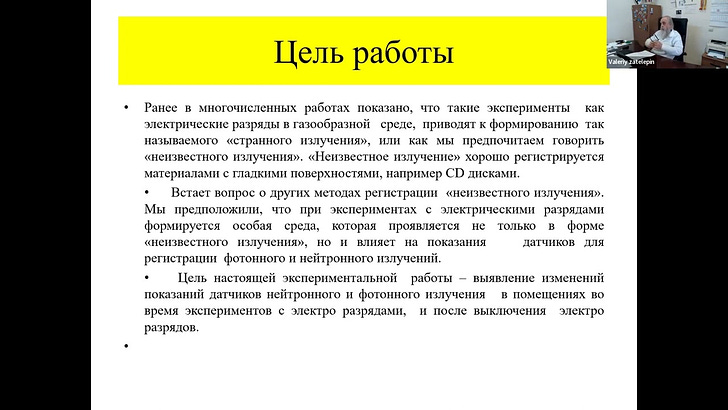Features of the radiation background in a room with electric discharges
Baranov D.S., Zatelepin V.N., Shishkin A.L. INLIS Laboratory, Moscow
Webinar №14 session winter - spring 2022 of the Klimov-Zatelepin seminar was held on May 18, 2022 (Wednesday) from 16:00 to 18:00 Moscow time.
Speakers Zatelepin V.N., Shishkin A.L.
The report presents unpublished working papers comparing radiation measurements in a laboratory where experiments with electric discharges in a water-air environment are carried out with radiation measurements outside the laboratory.
Previously, numerous works have shown that such experiments as electric discharges in a gaseous medium and electric explosion of titanium foils lead to the formation of the so-called "strange radiation", or, as we prefer to say, "unknown radiation". "Unknown radiation" is well recorded by materials with smooth surfaces, such as CDs.
The question arises of other methods for detecting "unknown radiation". We assumed that during experiments with electric discharges, a special environment is formed, which manifests itself not only in the form of "unknown radiation", but also affects the readings of sensors for recording photon and neutron radiation.
The purpose of this experimental work is to identify changes in the readings of neutron and photon radiation sensors in rooms during experiments with electric discharges, and after turning off the electric discharges.
Slides in Russian | Slides in English
I believe this work was in part inspired by MFMP findings in GS 5.2, Ohmasa Gas and VEGA that I discussed with Alexander Shishkin and other Russians at the start of December 2021.
During the Q&A to the presentation above, I reminded them of statements in the 1990s by Dr. Takaaki Matsumoto,
Proceedings of the 5th International Conference on Cold Fusion. 1995, p. 584
https://www.lenr-canr.org/acrobat/PonsSproceedinga.pdf
Emission of Radiations
Radiations were monitored by a Csl(Tl) scintillation spectroscopy, which was placed over the water surface. When the sparks appeared. the counting rate was significantly higher than the background. The energy spectra of the radiations were continuous and declined monotonously as the energy increased. The high energy tail expanded more widely as the voltage increased. The intensity of the radiations dropped sharply as the distance between the detector and the electrodes increased. The radiations were neither gamma rays nor X-rays. The signals were generated by electromagnetic waves picked up with the circuit.
p. 216
Ref. (59') J. New Energy, Vol. 1, No. 4, p. 79 (1996).
Emission of Radiation
The emission of radiations was monitored by the Csl(Tl) scintillation spectroscopy. Certain kinds of radiation were observed to be released through the wall of the glass beaker.
The Csl(Tl) scintillation detector was alternatively placed outside the glass beaker and over the water surface. The detector measured the emission of radiation in the high voltages in both cases. The energy spectrum of the radiations were continuous and monotonously declined as the energy increased. The typical spectra are shown in Fig. 6. The background was measured with no discharges. The counting rate was significantly higher than the background. As the voltage increased, the energy tail expanded more widely. The intensity of the radiation sharply dropped as the distance between the detector and the cathode increased.
The radiation detected was neither gamma rays nor X-rays. The signals were generated by electromagnetic waves picked up with the electrical circuit. The emission of the electromagnetic waves will be discussed relating to the break-up of the ironic clusters.
After the presentation, Dr. Alexander Parkhomov sent this to the group:
Miracles with dischargers
About 30 years ago I also experimented with spark gaps. Several Geiger counters (3 or 4) were located at a distance of 1-2 meters from the arrester. Usually, the inclusion of a spark gap did not cause noticeable changes in the operation of the counters. But once the usual inclusion caused a violent reaction from all working counters. The counting speed has increased hundreds of times. Fast counting did not stop after switching off the spark gap for several hours. It was not possible to reproduce this amazing phenomenon.
Once again, I observed an unexpected strong increase in the counting rate of Geiger counters while working with a plasma electrolysis reactor, such as the Bazhutov reactor. This is also a kind of electrical discharger. A nearby Geiger counter, which always showed a natural background, suddenly increased the counting rate tenfold for a few minutes. There were no changes in the operation of the reactor at that time. Nothing of the kind was subsequently observed.
Striking effects near spark gaps were observed by Igor Stepanov:
I.N. Stepanov. On the physical effects that occur when the Geiger counter STS-6 is exposed to radiation emanating from barium-titanate capacitors connected to a pulsed voltage source // Journal of Forming Directions of Science. 15-16(5), p. 94-96, 2017
http://www.unconv-science.org/pdf/15/stepanov-ru.pdf
Alexander Parkhomov




